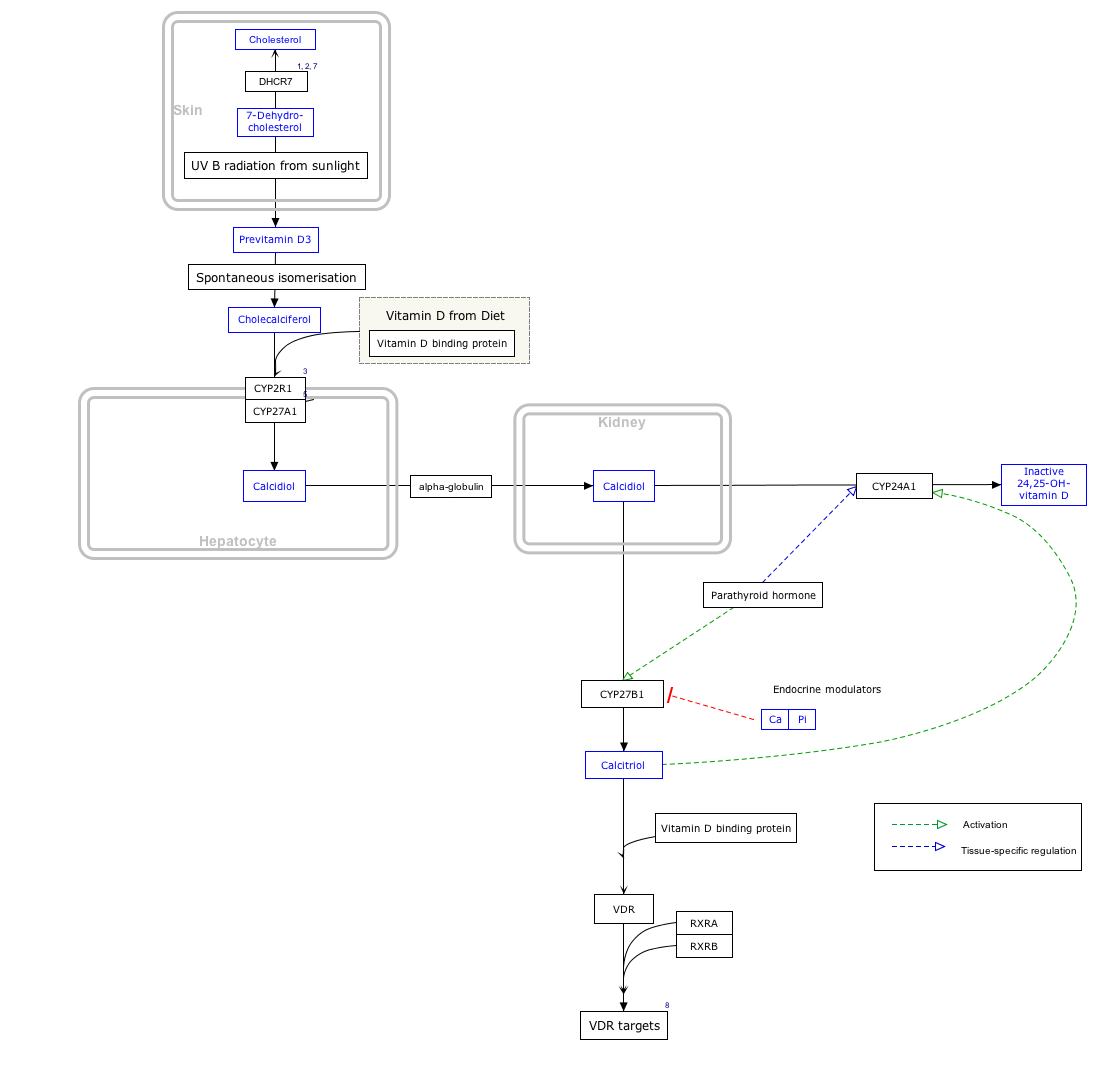7-デヒドロコレステロール
7-Dehydrocholesterol/ja

| |

| |
| Names | |
|---|---|
| IUPAC name
Cholesta-5,7-dien-3β-ol
| |
| Systematic IUPAC name
(1R,3aR,7S,9aR,9bS,11aR)-9a,11a-Dimethyl-1-[(2R)-6-methylheptan-2-yl]-2,3,3a,6,7,8,9,9a,9b,10,11,11a-dodecahydro-1H-cyclopenta[a]phenanthren-7-ol | |
| Identifiers | |
3D model (JSmol)
|
|
| ChEBI | |
| ChemSpider | |
| MeSH | 7-dehydrocholesterol |
PubChem CID
|
|
| UNII | |
| |
| |
| Properties | |
| C27H44O | |
| Molar mass | 384.638 |

7-デヒドロコレステロール(7-DHC)は動物ステロールの一種で、血清ではコレステロール前駆体として機能し、皮膚では光化学的に|ビタミンD3に変換されるため、プロビタミン-D3として機能する。ヒトの皮膚にこの化合物が存在することで、ヒトはビタミンD3(コレカルシフェロール)を製造することができる。 紫外線を浴びると、ビタミンDは生成される。太陽光に含まれるUV-Bを浴びると、7-DHCは中間異性体としてプレビタミンD3を経由してビタミンD3に変換される。また、いくつかの哺乳類の乳にも含まれている。羊毛を持つ哺乳類が自然に分泌するラノリンという蝋状の物質には7-DHCが含まれており、日光によってビタミンDに変換され、毛づくろいの際に栄養素として摂取される。昆虫では、7-デヒドロコレステロールは成虫になるために必要なホルモンエクダイソンの前駆体である。ノーベル賞受賞の有機化学者アドルフ・ウィンダウスによって発見された。
Biosynthesis
It is synthesized from lathosterol by the enzyme lathosterol oxidase (lathosterol 5-desaturase). This is the next-to-last step of cholesterol biosynthesis. Defective synthesis results in the human inherited disorder lathosterolosis resembling Smith–Lemli–Opitz syndrome. Mice where this gene has been deleted lose the ability to increase vitamin D3 in the blood following UV exposure of the skin.
Location
The skin consists of two primary layers: an inner layer, the dermis, comprising largely connective tissue, and an outer, thinner epidermis. The thickness of the epidermis ranges from 0.08 mm to greater than 0.6 mm (from 0.003 to 0.024 inches). The epidermis comprises five strata; from outer to inner, they are the stratum corneum, stratum lucidum, stratum granulosum, stratum spinosum, and stratum basale. The highest concentrations of 7-dehydrocholesterol are found in the epidermal layer of skin—specifically in the stratum basale and stratum spinosum. The production of pre-vitamin D3 is, therefore, greatest in these two layers.
Radiation
Synthesis of pre-vitamin D3 in the skin involves UVB radiation, which effectively penetrates only the epidermal layers of skin. 7-Dehydrocholesterol absorbs UV light most effectively at wavelengths between 295 and 300 nm and, thus, the production of vitamin D3 will occur primarily at those wavelengths. The two most important factors that govern the generation of pre-vitamin D3 are the quantity (intensity) and quality (appropriate wavelength) of the UVB irradiation reaching the 7-dehydrocholesterol deep in the stratum basale and stratum spinosum. Light-emitting diodes (LEDs) can be used to produce the radiation.
もう一つの重要な考慮点は、皮膚に存在する7-デヒドロコレステロールの量である。通常であれば、ヒトの皮膚の有棘層と基底層には、体内のビタミンDの必要量を満たすのに十分な量の7-デヒドロコレステロール(約25–50 μg/cm2 of skin)が存在する。7-DHCの不足は、ビタミンD欠乏症の別の原因として提唱されている。
供給源
7-DHCは動物や植物が異なる経路で産生する。真菌類ではかなりの量は生産されない。一部の藻類によって生産されるが、その経路はよくわかっていない。また、一部の細菌によっても生産される。
工業的には、7-DHCは一般的にラノリンに由来し、紫外線暴露によってビタミンD3を生成するために使用される。地衣類(クラドニア・ランギフェリナ)はビーガンD3の生産に使われる。
7-DHCは、陸上動物ではラノステロールを介して、植物ではシクロアルテノールを介して、藻類ではもう一つのプロビタミンDであるエルゴステロールとともにD2の合成に使われる。真菌類では、エルゴステロールのみがラノステロールを介したD2の合成に用いられる。
インタラクティブ経路マップ
Click on genes, proteins and metabolites below to link to respective articles. [§ 1]
- ↑ The interactive pathway map can be edited at WikiPathways: "VitaminDSynthesis_WP1531".
